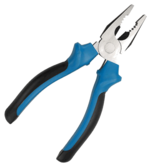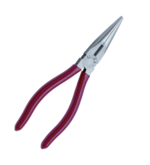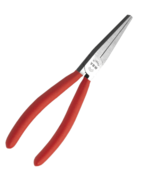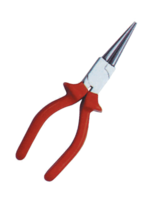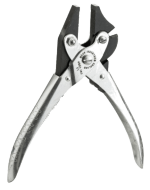Pliers and Cutters
From DT Online
As with Scissors and Pincers, most Pliers, Wire Cutters and Strippers are based on two Class 1 Levers operating together to provide the gripping action, although a few could be more accurately described as a Compound Lever (e.g. Parallel Action Pliers and Bolt Cutters).
| Combination Pliers | The most commonly used Pliers found in the toolbag of most tradesmen. The jaws are designed to grip both flat and round stock and there is the addition of a wire cutter (in between the jaws) and a wire stripper (on the outside of the jaws either side of the fulcrum). | |
| Snipe Nose Pliers | Also known as Long Nose Pliers or Needle Nose Pliers depending on the size and proportion of their jaws, these are almost as universally used as Combination Pliers but they can reach into more inaccessible areas (at the cost of some loss of grip). | |
| Flat Nose Pliers | These have tapered jaws that are serrated on their flat inner surfaces enabling them to be used to grip and bend small metal parts and to twist together wires | |
| Round Nose Pliers | Most commonly used by Jewellers, Silversmiths and Electricians to create loops in the end of wire. | |
| Parallel Action Pliers | The jaws open and close parallel along their entire length to produce a square vice-like grip. The Compound Lever action operates on a Parallelogram type arrangement to produce a considerable Mechanical Advantage for both cutting and gripping operations. | |
| # | # | [[File:###|150px|right]] |
| # | # | [[File:###|150px|right]] |
| # | # | [[File:###|150px|right]] |
| # | # | [[File:###|150px|right]] |
| # | # | [[File:###|150px|right]] |
